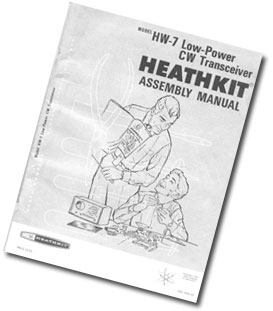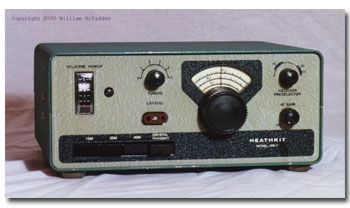
by William Eric McFadden
From the manual:
-
The Model HW-7 Heathkit Transceiver is a three-band QRP (low power) CW Transceiver with both built-in VFO and crystal transmit provisions. Band coverage is the CW portion of forty, twenty, and fifteen meters. The Transceiver can be operated from the Heathkit Accessory Power Supply Model HWA-7-1, an equivalent low impedence power supply, or batteries. The experienced amateur, QRP man, and novice alike will appreciate the dependability and versatility of this Transceiver.Whether you use it for standby, camping, emergency operation, or your primary rig, the Transceiver will prove its worth. Band changing and tune-up are easily accomplished with pushbutton band selection and single-control Tuning. The light-weight and compact Transceiver has pushbutton crystal transmit provisions for the novice or QRP roundtables. Main tuning is accomplished through a 6-to-1 vernier that is virtually backlash free. A Relative Powermeter, built-in sidetone, and carry-along size make the Transceiver a pleasure to operate.
Specifications: General Frequency Coverage 40 meters, 7.0 to 7.2 MHz 20 meters, 14.0 to 14.2 MHz 15 meters, 21.0 to 21.3 MHz Frequency Stability less than 100 Hz drift after 10 minutes warmup Power Requirements 13 volts DC, nominal. 35 mA receive mode and 450 mA transmit mode Active Devices synchrodyne detector, 40673 dual-gate MOSFET audio amplifier, CA3035V1 integrated circuit VFO and buffer, MPF105 JFET doubler/tripler, MPS6521 silicon transistor driver, MPS6521 silicon transistor final amplifier, two MPSU05 silicon transistors sidetone oscillator, 2N3393 silicon transistor and X29A829 silicon transistor break-in keying, 2N3393 silicon transistor and X29A829 silicon transistor transmitter keying, S2091 silicon transistor Dimensions 9-¼" wide x 8-½" deep x 4-¼" high, including knobs and feet Weight 4 lbs. 8 oz. Transmitter DC Power Input 40 meters -- 3 watts 20 meters -- 2.5 watts 15 meters -- 2 watts Frequency Control 40 meter crystal or built-in VFO on 40 meters 20 meter crystal or built-in VFO on 20 meters 15 meter crystal or built-in VFO on 15 meters Output Impedence 50 ohms unbalanced Sidetone built-in Spurious and
Harmonic Levelsat least 25dB down Receiver Sensitivity less than 1 microvolt provides readable signal Selectivity 2 kHz at 6dB down Type of Reception CW or SSB Audio Output Impedance 1000 ohms nominal
The HW-7 was the first QRP transceiver offered by Heathkit. It was available from 1972 through 1975. The HW-7 provided coverage of 40, 20, 15 meter bands. The transceiver featured a very simple direct-conversion receiver design and this simple design led to performance problems including sometimes-severe broadcast-band interference, microphonics, and AC hum. According to the January, ARRL review (January, 1973), the original price of the HW-7 was about $70.
 I built an HW-7 in the late seventies when I held a Novice license. The kit was purchased on
close-out from Heathkit after the introduction of the HW-8. (If memory serves, the close-out price was $40,
and my parents paid half.) This rig was a miserable performer and very few contacts were made with it. I
had installed a choke to reduce common-mode hum and an MFJ CWF-2 four-stage active audio filter. This HW-7
was lost in the 1989 fire.
I built an HW-7 in the late seventies when I held a Novice license. The kit was purchased on
close-out from Heathkit after the introduction of the HW-8. (If memory serves, the close-out price was $40,
and my parents paid half.) This rig was a miserable performer and very few contacts were made with it. I
had installed a choke to reduce common-mode hum and an MFJ CWF-2 four-stage active audio filter. This HW-7
was lost in the 1989 fire.
My current HW-7 was purchased from NS8O who had significantly improved the receiver's front-end. This rig is a much better performer than my original one was and is pleasant to operate.
The HW-7 is designed for use with high-impedence mono headphones. Before I found a proper set of vintage Trimm Featherweight headphones, I used modern low-impedence stereo headphones with an impedence adapter (image) built around a Radio Shack #273-1380 audio transformer.
I plan to install a Small Wonder Labs Freg-Mite audible frequency counter (link) in my HW-7 at some point. This clever device announces the VFO frequency in morse code at the press of a button and will allow me to know my precise frequency no matter where on the dial I am.
An extremely useful reference on the HW-7 is Michael Bryce's HW-8 Handbook, Second Edition. This book provides circuit descriptions, schematics, board layouts, alignment instructions, Heathkit service bulletins, and modifications for the HW-7, HW-8, and HW-9. It is available at Michael Bryce's The Heathkit Shop, at Kanga, USA, and at QRP ARCI. The older, First Edition, HW-8 Handbook has modifications for the HW-7, HW-8, and HW-9 but lacks the other valuable content.
HW-7 Links
- HW-7 at rigpix.com
- Heathkit Classic QRP Rigs at ARRL
- KK4KF's Heathkit HW-7/8/9 Information Page with service bulletins and mods
- The following articles are available to ARRL members; search the QST Archives:
- Recent Equipment: Heath HW-7 CW QRP Transceiver,
by Doug DeMaw, W1CER (January, 1973) - Heath HW-7 Preselector Modification,
by R.J. Harker, WN9JML (May, 1973 QST) - Hints and Kinks: Receiver Offset Tuning for the HW-7,
by Glen Carlson, W6KVD (June, 1973 QST) - New Front End for the Heath HW-7,
by Jerry Wine, KH6HKZ (December, 1973 QST) - HW-7 QRP Transceiver Modifications,
by Doug De Maw, W1CER (January, 1974) - RIT for the HW-7,
by John Grebenkemper, WA6BVA (July, 1975 QST) - Slippers for the HW-7 Transceiver,
by Doug DeMaw, W1CER (December, 1975 QST) - Hints and Kinks: Hum Reduction in the HW-7,
by Bruce Ault, WA4UVG (July, 1976 QST) - Hints and Kinks: Heath HW-7 Sidetone Level Control,
by David Palmer, W6PHF (November, 1976 QST) - Hints and Kinks: HW-7/HW-8 Interference,
by John Czap, WB2LGS (December, 1978 QST) - QRP Power: Vintage QRP,
by Rich Arland, K7SZ (September, 2000 QST)
Attribution: scan of HW-7 manual cover from the Boat Anchor Manual Archive.
